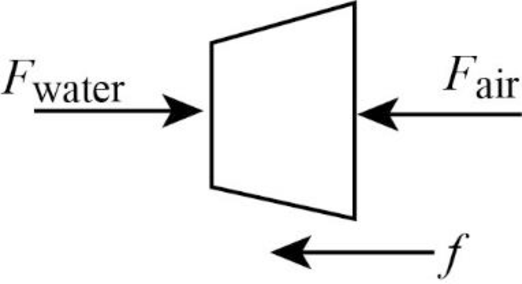
A village maintains a large tank with an open top, containing water for emergencies. The water can drain from the tank through a hose of diameter 6.60 cm. The hose ends with a nozzle of diameter 2.20 cm. A rubber stopper is inserted into the nozzle. The water level in the tank is kept 7.50 m above the nozzle. (a) Calculate the friction force exerted on the stopper by the nozzle. (b) The stopper is removed. What mass of water flows from the nozzle in 2.00 h? (c) Calculate the gauge pressure of the flowing water in the hose just behind the nozzle.
(a)
The friction force exerted on the stopper by the nozzle.
Answer to Problem 45P
The friction force exerted on the stopper by the nozzle is
Explanation of Solution
Take point 1 to be at the free surface of the water in the tank and point 2 to be inside the nozzle. Since the top of the tank is open to the atmosphere the pressure at point 1 will be equal to atmospheric pressure. Since the tank has large area compared to the nozzle, the speed of water at point 1 will be very small compared to that at point 2 according to continuity equation and can be considered to be zero. Also assume the position of the nozzle to be
Write the Bernoulli’s equation.
Here,
Substitute
The diagram of the different forces on the system is shown below.

In the diagram
The sum of the forces in the horizontal direction must be zero for the stopper.
Write the equilibrium condition for the stopper.
Here,
Write the expression for
Here,
Put the above equation in equation (III) and rewrite it for
Write the equation for pressure.
Here,
Rewrite the above equation for
Use equation (V) to write the expression for
Here,
Use equation (V) to write the expression for
Put the above two equations in equation (IV).
Write the equation for
Here,
Put equations (II) and (VII) in equation (VI).
Conclusion:
The value of
Substitute
Therefore, the friction force exerted on the stopper by the nozzle is
(b)
The mass of water that flows from the nozzle in
Answer to Problem 45P
The mass of water that flows from the nozzle in
Explanation of Solution
When the stopper is removed, point 2 is also at the atmospheric pressure.
Substitute
Write the equation for density of water.
Here,
Write the equation for volume of water.
Here,
Write the equation for the velocity of water at point 2.
Here,
Rewrite the above equation for
Put equation (IX) in the above equation.
Put equations (VII) and (XII) in equation (XI).
Put the above equation in equation (X) and rewrite it for
Conclusion:
Substitute
Therefore, the mass of water that flows from the nozzle in
(c)
The gauge pressure of the flowing water in the hose just behind the nozzle.
Answer to Problem 45P
The gauge pressure of the flowing water in the hose just behind the nozzle is
Explanation of Solution
Assume point 1 to be in the wide hose and point 2 to be just outside the nozzle.
Write the continuity equation of fluids.
Here,
Write the equation for
Here,
Write the equation for
Put the above two equations in equation (XIV) and rewrite it for
Take the vertical position of point 1 and point 2 to be zero.
Substitute
Conclusion:
Substitute
Substitute
Substitute
Therefore, the gauge pressure of the flowing water in the hose just behind the nozzle is
Want to see more full solutions like this?
Chapter 15 Solutions
Principles of Physics: A Calculus-Based Text
Additional Science Textbook Solutions
Chemistry: The Central Science (14th Edition)
Organic Chemistry
Loose Leaf For Integrated Principles Of Zoology
Fundamentals Of Thermodynamics
Campbell Essential Biology with Physiology (5th Edition)
Biology: Life on Earth (11th Edition)
- 2. Max is swimming across a river that is 42.6 m wide. He can swim at 1.6 m/s and heads 20° to the right of the vertical. There is a current pushing him more to the right and it has a speed of 0.30 m/s. Determine the time it takes him to cross the river and find out how far downstream he ends up. Draw the diagram.arrow_forwardpls help asaparrow_forwardpls help asaparrow_forward
 Principles of Physics: A Calculus-Based TextPhysicsISBN:9781133104261Author:Raymond A. Serway, John W. JewettPublisher:Cengage Learning
Principles of Physics: A Calculus-Based TextPhysicsISBN:9781133104261Author:Raymond A. Serway, John W. JewettPublisher:Cengage Learning Physics for Scientists and Engineers: Foundations...PhysicsISBN:9781133939146Author:Katz, Debora M.Publisher:Cengage Learning
Physics for Scientists and Engineers: Foundations...PhysicsISBN:9781133939146Author:Katz, Debora M.Publisher:Cengage Learning Physics for Scientists and Engineers, Technology ...PhysicsISBN:9781305116399Author:Raymond A. Serway, John W. JewettPublisher:Cengage Learning
Physics for Scientists and Engineers, Technology ...PhysicsISBN:9781305116399Author:Raymond A. Serway, John W. JewettPublisher:Cengage Learning College PhysicsPhysicsISBN:9781938168000Author:Paul Peter Urone, Roger HinrichsPublisher:OpenStax College
College PhysicsPhysicsISBN:9781938168000Author:Paul Peter Urone, Roger HinrichsPublisher:OpenStax College Physics for Scientists and EngineersPhysicsISBN:9781337553278Author:Raymond A. Serway, John W. JewettPublisher:Cengage Learning
Physics for Scientists and EngineersPhysicsISBN:9781337553278Author:Raymond A. Serway, John W. JewettPublisher:Cengage Learning Physics for Scientists and Engineers with Modern ...PhysicsISBN:9781337553292Author:Raymond A. Serway, John W. JewettPublisher:Cengage Learning
Physics for Scientists and Engineers with Modern ...PhysicsISBN:9781337553292Author:Raymond A. Serway, John W. JewettPublisher:Cengage Learning





